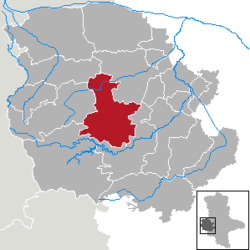Blankenburg (Harz)
| Blankenburg | ||
|---|---|---|

Blankenburg seen from the Eichenberg to the west of the town
|
||
|
||
| Coordinates: 51°47′43″N 10°57′44″E / 51.79528°N 10.96222°ECoordinates: 51°47′43″N 10°57′44″E / 51.79528°N 10.96222°E | ||
| Country | Germany | |
| State | Saxony-Anhalt | |
| District | Harz | |
| Government | ||
| • Mayor | Heiko Breithaupt (CDU) | |
| Area | ||
| • Total | 148.91 km2 (57.49 sq mi) | |
| Elevation | 288 m (945 ft) | |
| Population (2015-12-31) | ||
| • Total | 20,294 | |
| • Density | 140/km2 (350/sq mi) | |
| Time zone | CET/CEST (UTC+1/+2) | |
| Postal codes | 38889 | |
| Dialling codes | 03944 | |
| Vehicle registration | HZ | |
| Website | [1] | |
Blankenburg (Harz) is a town and health resort in the district of Harz, in Saxony-Anhalt, Germany, at the north foot of the Harz Mountains, 12 miles (19 km) southwest of Halberstadt.
It has been in large part rebuilt since a fire in 1836, and possesses a castle, with various collections, a museum of antiquities, an old town hall and churches. There are pine-needle baths and a psychiatric hospital. Gardening is a speciality. The nearby ridge of rocks called the Teufelsmauer (Devils Wall) offers views across the plain and into the deep gorges of the Harz.
The town of Blankenburg (Harz) lies on the northern edge of the Harz mountains at a height of about 234 metres. It is located west of Quedlinburg, south of Halberstadt and east of Wernigerode. The stream known as the Goldbach flows through the district of Oesig northwest of the town centre.
The borough includes the following parishes:
In addition there are the following unofficial names for districts in the town:
Clockwise from the north:
The first traces of settlement date to the Old Stone Age, but the first recorded mention of Blankenburg goes back to 1123. The Saxon duke, Lothair of Supplinburg, installed Poppo, a nephew of Bishop Reinhard of Halberstadt, as count at the castle, which stood on a bare limestone rock on the site of the present castle. The name of the town derives from this castle.
Count Poppo I of Blankenburg very probably came from the Frankish noble family of Reginbodonen. His descendants were also subject to the nearby Regenstein Castle. This was a fief from the Bishopric of Halberstadt like the County of Blankenburg, also called the Hartingau. In 1180/82 Frederick Barbarossa had Blankenburg devastated because it had pledged "sole allegiance" to the Welf, Henry the Lion. In 1386 Blankenburg suffered heavy destruction again.
...
Wikipedia



